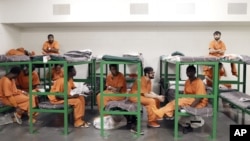On a day when the Pentagon announced it is lifting its ban on transgender men and women openly serving in the U.S. military, a research institute in California announced findings that the number of men and women identifying as transgender has doubled over the last 10 years.
Jody Herman, a public policy scholar at the Williams Institute at the University of California at Los Angeles, told VOA Thursday that the results are from people self-reporting on U.S. government surveys. She said while the study did not examine the factors behind the rise in self-identification, growing social acceptance of transgender people might have influenced the rise in numbers.
"That's one possible explanation," she said, "that it's becoming more mainstream." She says that as social acceptance of transgender identity grows, it is likely that people would be more willing to identify as such on a survey.
Four Williams Institute researchers — Herman, Gary Gates, Andrew Flores and Taylor Brown, all public policy experts — compiled their results from the surveys by the U.S. Centers for Disease Control that ask respondents if they identify as transgender.
A previous study compiled from data collected in 2003 and 2007-2008 estimated that 0.3 percent of the U.S. population identified as transgender. The new results, using a larger sample size, put the estimate at 0.6 percent across the United States, with extremes of 0.3 percent estimated in the sparsely populated, conservative state of North Dakota and 0.8 percent in the Pacific Island state of Hawaii.
Bigger sample, better data
Because the transgender question was an optional part of the survey, the earlier study had data only from the states of California and Massachusetts. The latest study, using 2014 data, had responses to the question from 19 states, enabling the researchers to use more sophisticated tools to estimate the transgender population across all 50 states.
The newer method relies on demographic information such as race, ethnicity, age and educational level to predict the likelihood that an individual would identify as transgender in states where that information was not available.
Perhaps not surprisingly, younger people — those between the ages of 18 and 24 — were more likely than older people to identify as transgender. They were also more likely to be of racial or ethnic minorities, and to have lower incomes.
In some cases, the demographic factors explained results that might otherwise seem surprising. The conservative southern state of Texas, for example, had a transgender population on the high end of the scale, at 0.6 percent. But 38 percent of the Texas population is Latino, according to the Pew Research Center, and Latinos are more likely than whites to identify as transgender.
It might be worth noting that a study of transgender identification does not equal a study of sexual orientation, although those identifications can coincide.
"Transgender people can be of any sexual orientation," Herman said. "But you do of course see LGBT together quite a bit" — the acronym that represents "lesbian, gay, bisexual, and transgender."
Herman explains that those groups might be referenced together because they tend to experience the same types of discrimination, even when they don't overlap.
"There has been some research to suggest that people who are [homosexual or bisexual] are discriminated against because they don't express gender in a traditional way, and you hear about trans people experiencing discrimination because of anti-gay bias," she said.
Follow-up
Herman says researchers might do another follow-up study in the future, although nothing has been scheduled. She says five more U.S. states added the transgender question to their surveys for 2015, and if more follow suit, "that would certainly be a reason to re-do the study."
Was the study done in service to any particular policy goal? Herman says while the mission of the Williams Institute is to study law and policy issues centered on sexual orientation and gender identity, the researchers' goal is only to provide data.
"We try to be timely and put out research that can dispel myths with facts and figures. We try to inject policy debates with solid, rigorous research," she said. "To the extent that people can get the information they need, that's great. That's the mission of the Williams Institute."















